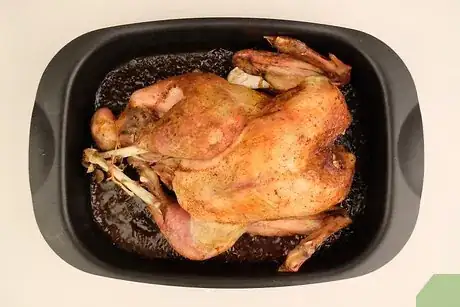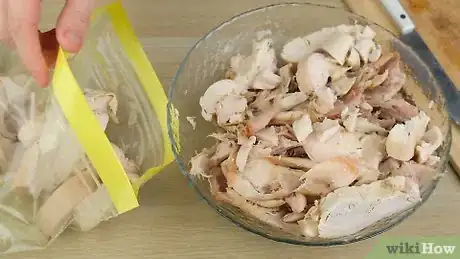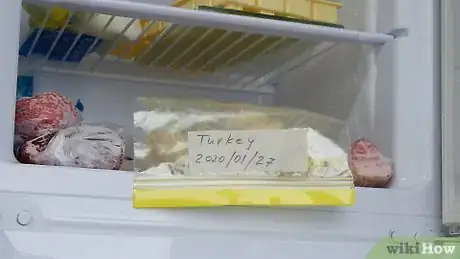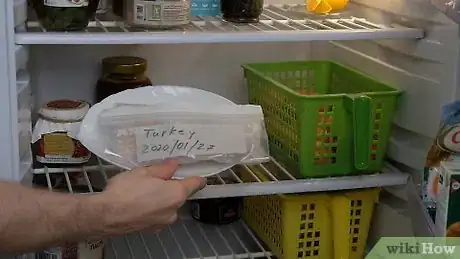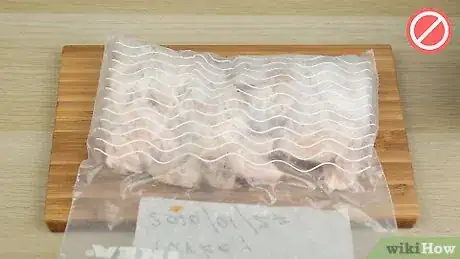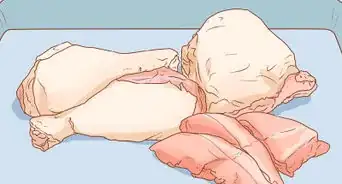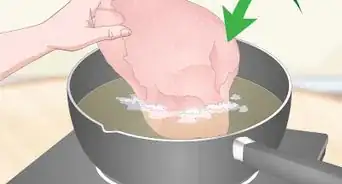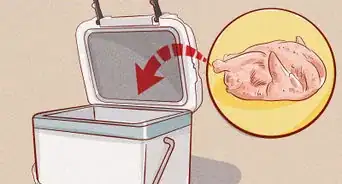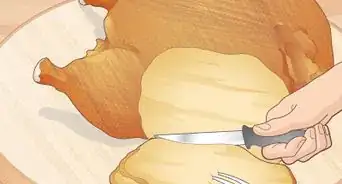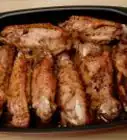This article was co-authored by JoAnna Minneci. JoAnna Minneci is a Professional Chef based in the Nashville, Tennessee area. With more than 18 years of experience, Chef JoAnna specializes in teaching others how to cook through private cooking lessons, team-building events, and wellness and nutrition classes. She has also appeared in numerous television shows on networks such as Bravo and Food Network. Chef JoAnna received Culinary Arts training from the Art Institute of California at Los Angeles. She is also certified in sanitation, nutrition, kitchen management, and cost control.
This article has been viewed 46,377 times.
If you've cooked a turkey and want to freeze the leftovers for later, the most important thing is to package the turkey tightly and securely. Cut the cooked turkey up into pieces before putting it in a freezer-safe plastic bag or container. Remove as much air as possible to prevent freezer burn and label the container with the date so you know when you put the turkey in the freezer.
Steps
Packaging Turkey for the Freezer
-
1Let the turkey cool in the fridge before packaging it. It’s important to let the turkey cool down completely before placing it in the freezer container or bag to help preserve the taste. Set the turkey in the fridge and wait roughly 20-30 minutes to let it cool down.[1]
- Once the temperature reaches above 40 °F (4 °C), bacteria can begin growing, which is why it's important not to leave the turkey out at room temperature for too long.
- Keep the turkey covered while it's in the fridge.
-
2Remove the bones and skin from the turkey. This makes the freezing and thawing process easier. Carefully peel off the skin and remove any bones that are still attached.[2]
- Either throw the bones away or store them in a separate container to turn into turkey stock. You can make a wonderful soup with the carcass if you choose to save it!
- Wash your hands before and after touching the turkey.
Advertisement -
3Slice the cooked turkey into pieces for easier freezing. Use a sharp knife to cut the turkey into slices, making sure the slices aren’t more than 3 inches (7.6 cm) thick. Cutting the poultry into slices will make it easier to freeze and then reheat later on.[3]
- It’s okay if the turkey is in very small chunks or slices, or even diced.
- If you freeze your entire turkey, you'll have to eat your entire turkey whenever you defrost it. It's better to divide your meat in 6-8 portions so you can thaw it out in chunks.
-
4Place the turkey in a compact freezer-safe bag or container. A freezer-safe bag is best because you can squeeze out all of the excess air easily to prevent freezer burn. A storage container works as well, but choose one that’s just big enough to hold the amount of turkey you’re storing.[4]
- Using a storage container that’s just the right fit for the amount of food you’re storing will help limit air exposure.
-
5Label the bag or container with the date so you know when it was frozen. If you’re using a plastic bag, write directly onto the bag using a permanent marker. If you’re using a reusable storage container, place a piece of tape on the container and write on top of the piece of tape. Write down the date you cooked it as well as the date it was put into the freezer.[5]
- Label it with “turkey” so you know what kind of food it is, if desired.
-
6Keep the turkey in the freezer for up to 9 months. Check that your freezer is set to 0 °F (−18 °C) or lower to be sure the turkey will last this long. While it can last for up to 9 months, it’s best to eat it within the first 3-6 months for the best taste.[6]
Thawing the Turkey
-
1Place the turkey in the fridge to thaw for 24-48 hours. The best way to thaw your turkey is by putting it in the refrigerator to thaw slowly at a constant cold temperature. Depending on how large your turkey is, if you place it in the fridge overnight, it’ll likely be thawed the next day.[7]
- It usually takes 4 hours for 1 pound (450 g) of turkey to thaw.
-
2Thaw the turkey in cold water to defrost it faster. Fill a basin or plug your sink to fill it with cold water. Use enough water to cover the package of turkey, making sure there’s water on all sides. Change the water every 30 minutes and keep an eye on the turkey to ensure you remove it from the water as soon as it’s thawed.[8]
- Check that the plastic bag or container is sealed tightly before placing it in the water so there aren’t any leaks.
-
3Avoid placing the turkey on the counter to thaw it. Setting your turkey out to thaw at room temperature isn’t safe as bacteria can start to quickly multiply once the turkey reaches a certain temperature. Always thaw your turkey by placing it in the fridge or in cold water to ensure it doesn’t spoil.[9]
- Even though most of the bacteria is killed off when you reheat the turkey in the oven or microwave, some types of bacteria still linger even after going through heat.
Things You'll Need
Packaging Turkey for the Freezer
- Sharp knife
- Freezer-safe bag or container
- Tape (optional)
- Permanent marker
Thawing the Turkey
- Basin or sink (optional)
- Cold water (optional)
References
- ↑ https://www.familyeducation.com/life/food-storage/tips-freezing-thawing-foods
- ↑ https://www.thekitchn.com/the-thanksgiving-leftovers-you-can-freeze-or-shouldnt-freeze-tips-from-the-kitchn-213356
- ↑ https://www.familyeducation.com/life/food-storage/tips-freezing-thawing-foods
- ↑ https://www.epicurious.com/holidays-events/how-to-freeze-thanksgiving-leftovers-article
- ↑ https://www.familyeducation.com/life/food-storage/tips-freezing-thawing-foods
- ↑ https://www.foodsafety.gov/food-safety-charts/cold-food-storage-charts
- ↑ https://www.familyeducation.com/life/food-storage/tips-freezing-thawing-foods
- ↑ https://www.familyeducation.com/life/food-storage/tips-freezing-thawing-foods
- ↑ https://www.thekitchn.com/all-the-wrong-ways-to-thaw-a-turkey-225711
